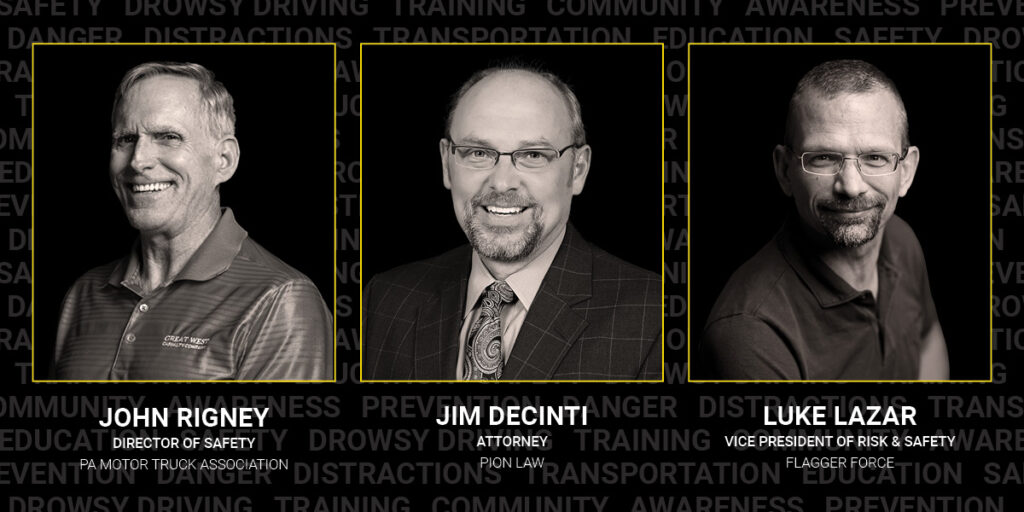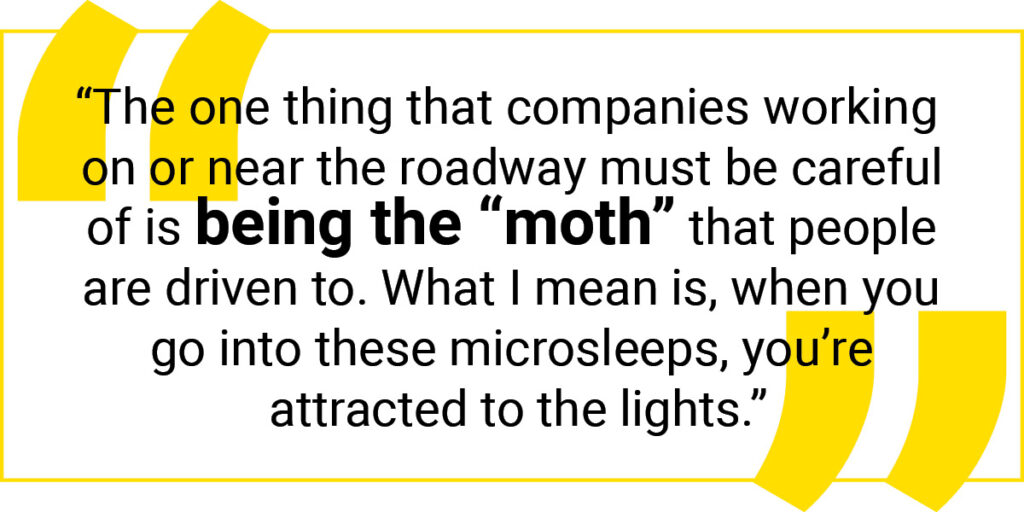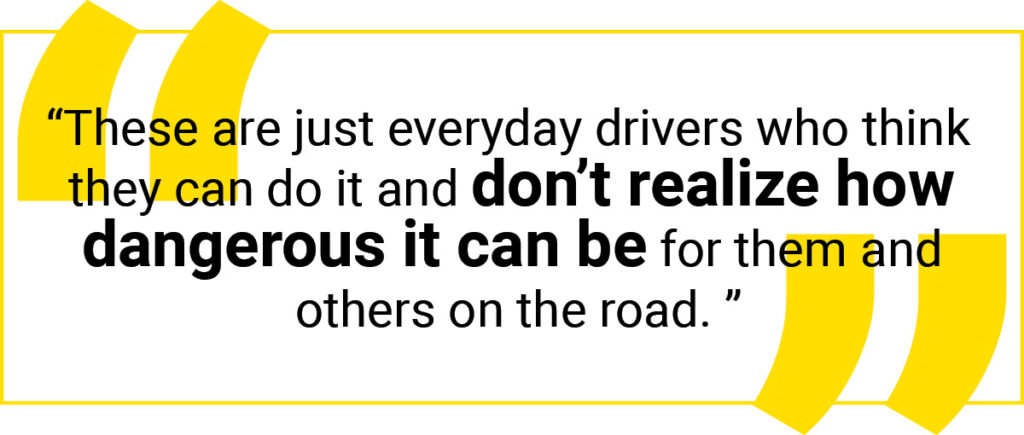As a Safety-Driven® organization, Flagger Force strives to lead the traffic control industry in best practices for managing safety on the road. An essential component of roadway safety is raising awareness and implementing prevention measures to combat hazards, like drowsy driving.
Luke Lazar, vice president of risk and safety for Flagger Force recently participated in a discussion with fellow safety professionals, Jim DeCinti, attorney at Pion Law, and John Rigney, director of safety with the Pennsylvania Motor Truck Association (PMTA), to talk about the dangers of drowsy driving and offer their prevention and awareness tips from the perspectives of their respective industries.
Participants
John Rigney, director of safety, PA Motor Truck Association
Jim DeCinti, attorney, Pion Law
Luke Lazar, vice president of risk & safety, Flagger Force

Can you share a little bit about your background and how you landed in your current positions?
Jim: I am an attorney with the Pittsburgh-based law firm Pion Law, working from the Harrisburg office. We specialize in transportation law, defending truck drivers, trucking companies, insurance companies who write insurance for those, and large commercial fleets, such as Flagger Force. We are a specialized transportation niche firm. That’s 95% of our business. I’ve been with the firm since the beginning of 2010. We’re in our 12th year, and I handle a variety of trucking and transportation-related matters in Pennsylvania state and federal courts.
John: I spent 27 and a half years with the Pennsylvania State Police and then retired to move on to Keen Transport in 2011. I learned a lot about drivers and load securement from those experiences before getting recruited by a large retailer as a safety manager for five years. I’ve been involved with PMTA for quite a long time before joining their organization in 2020.
Luke: I serve as vice president of risk and safety for Flagger Force. I am responsible for risk management, safety, training, and quality assurance for our team and clients. In the safety role, a large part of what we do is manage our fleet. We have approximately 1,000 pickup trucks throughout the east coast. Although not commercial motor vehicles or CDL drivers, we also have some larger trucks. Leading up to Flagger Force, I led the safety program at RETTEW, an consulting services firm, advising organizations on their risk mitigation programs for close to nine years and a variety of other experiences that brought me to this stage in my career.
What are the dangers of drowsy driving?
Jim: From the perspective of a commercial motor vehicle driver, the dangers of drowsy driving are readily apparent. You’re driving down the road with 80,000 pounds that you are responsible for, and you don’t even need to completely fall asleep to pose a danger; all you need to do is one of those little doze-offs or even a momentary lapse of attention, and it could result in catastrophic injuries, including injury to yourself.
Luke: We have multiple environments where drowsy driving poses a danger. We drive more than a million miles a month on the road. Our drivers being drowsy could be a hazard, and other drivers being drowsy is dangerous. Then obviously, we have our employees within work zones at risk, whether it’s actively setting up the work zone, actively flagging, or breaking down the work zone, where a drowsy driver may erroneously enter those areas.
John: Many things go into “making” a drowsy driver, from what you eat, your lack of sleep, your time on task, and the type of task you’re doing. There are a lot of people that like to leave early in the morning on a trip, say two or three in the morning, but they usually start their day at nine or ten. That first hour of driving is the most dangerous, especially if you’re headed east, and the sun’s coming up. I spent 14 years out on the Pennsylvania Turnpike and single-vehicle crashes in the morning and evening were the most common crashes because you’re squinting your eyes, you’re tired from work, or you’re tired because you just got up. You may have heard the phrase before because it is true: drowsy driving is more dangerous than a drunk driver. Most drunk drivers know they’re drunk, and they know they must be careful, but when you’re a drowsy driver, you think you’re okay, you roll the window down, turn the radio up. Next thing you know, you’re sleeping.

Who do you encounter in your industry that’s most likely to drive drowsy?
John: I think it’s the people doing shift work, maybe working overtime in our communities. Local drivers seem more apt to not get enough sleep because when they are home, they can support their families or other hobbies they may be interested in.
Long-haul drivers are also another group you may encounter on the roads. Years ago, they had paper logbooks to track their hours and miles driven. It was easier for them to fudge it to make a little extra money because they get paid by the mile and push it. Back then, the most dangerous thing for long-haul drivers was a soda can—they were always reaching for a can of soda when they crashed. They were more apt to be the ones to be drowsy. Now, with the electronic logs, it doesn’t stop the violations altogether, but they can’t fudge it as easily. So, the local drivers that don’t have to do the logs are more apt to be the ones that will push their time. I believe today, drivers can drive up to 150 air miles, which is about a 14-hour day, while only driving 11 of those hours. With today’s employment situations, some companies may be treading water and must push those drivers a little bit harder. They have to work overtime, so it’s a different mix of people now.
Luke: At Flagger Force, I think it is people we see with changes with their shift, particularly when they change to an earlier start. It doesn’t seem as much with the longer days, tagging a few hours on the end of a person’s workday. It seems to be when a person has to leave a few hours earlier in the morning. And we encounter it more in road conditions that would be more monotonous, like the turnpike, where people get in the zone of driving on a highway, set the cruise control, and relax a little bit. We generally encounter it with our drivers more often in the morning than in the evening.
Jim: John makes a great point about the logs. When there were paper logs, drivers could be “cowboys.” They could punch their logs to make it look like they only drove 11 hours, but they were driving 24 hours. You can’t do that as much now. The other thing that has changed is the advent of cameras inside the vehicles and drivers knowing that they’re on camera–it gives them a second thought about, “All right, am I ready to go here?” From my position, I’m mostly working with safety teams, training, and the drivers that may be in an accident. I’ve seen countless driver-facing dashcam videos with my driver just dozing off, and you interview them, and they say, “No, I wasn’t dozing off.” And then you show them the video, and they were dozing off. Luke’s point is very well taken. I think earlier in the morning is the key when people aren’t used to it.
In my experience now, I don’t see too many truck drivers who are dozing off because they have rules they have to follow, breaks they must take, limits on the number of hours they can drive, and hours they can work. But when I do see it, it’s usually because they had a bad night of sleep, it’s cold, they couldn’t get comfortable, or whatever the case may be. They might have been in the sleeper berth for 10 hours, but they might have only had 2 hours of sleep. And that’s where I see it the most.
How common is drowsy driving; how often do you encounter the issue in your field?
John: I think that the players have changed. Companies and regulations have increased the air miles, and now drivers have 150 air miles with a 14-hour day to get to 11 hours of driving, it has extended the time frame for the drivers a little bit. That two to three hours can make a difference depending on when you start your day.
The one thing that companies working on or near the roadway must be careful of is being the “moth” that people are driven to. What I mean is, when you go into those microsleeps, you’re attracted to the lights. That’s why they no longer allow trucks to park on the side of the road on the Pennsylvania Turnpike because drowsy drivers are drawn to the running lights of vehicles. Drowsy drivers could think a vehicle on the shoulder is moving and wind up driving underneath it. It’s dangerous. Drivers’ eyes pick up a bright object, orange vest, flashing amber lights for emergency vehicles–and kaboom, you have a major catastrophe.
I also think it varies with the economy. When people are doing well, and they’re comfortable, and they don’t feel that they need to push themselves to make the extra buck, work the extra time, or take the earlier shift to get the shift differential, they don’t have the same stresses on them because they’re able to sleep. But right now, this is a bad time for everybody. I think now is when you must be careful because people are working two or three jobs just to make ends meet.
Luke: I think there’s a lot to be said about the economic stressors imposed. Many driving jobs are in a lower wage range, so people tend to try and push things a little bit further. We see a cyclical process with the change of seasons, the changes in the clock, and the changes in daylight. We do significant internal and external communication campaigns every spring and fall with the changing of the clock to try and help with some prevention and awareness. We also see it more at the beginning than at the end of the week. People may be inclined to be on a routine and a schedule during the week; they go to bed at 10:00 p.m. and get up at 6:00 a.m. to go to work. On the weekend maybe they’re enjoying themselves a little bit more. Their general health is down a little bit. Perhaps they’re a little dehydrated, and then they get behind the vehicle’s wheel first thing in the morning. It’s cyclical. We’ll go through significant periods where we see none of it. And it feels like the moment we let our guard down, we see it, right? So, we try not to let our guard down. We try to be proactive.
Thanks to forward- and cab-facing cameras with our vehicles, we do have a lot of analytics. We can watch our vehicles and see what driving behaviors or trends are going on. Flagger Force also monitors employee hours and does a lot to try and prevent drowsy driving, but it still has a significant human factor. There still is likely somewhere between 10 and 15 hours between when people are not at work that we can’t control, and diets, sleep habits, and all those other things absolutely play into it. There are significantly more regulatory controls in the trucking industry, including all the logging of hours in service driving and mandatory physicals. Still, we’re not quite held to that standard since our driving is more commuting miles, so we develop our own measures to ensure our team members and others on the road are safe. For instance, we require a valid driver’s license for our employees, and they are given driver safety training before operating a company vehicle. These practices ensure we provide them with the resources they need to stay safe.

What are some ways to avoid or prevent drowsy driving from your perspective?
Jim: The “Class A” commercial drivers are governed by the Federal Motor Carrier Safety Regulations. From our perspective, the hours-of-service regulations are probably the most outward device that tries to help drivers maintain their acuteness and not fall subject to drowsy driving. They’re limited to 11 hours of driving a day, limited to 14 hours of work a day, and required to take 30-minute breaks during an eight-hour period. They must pull over, take and log a break, and do something to rest. It doesn’t say what they need to do on that break, but they need to take a break from driving. Whether they go off duty, whether they go in and get a coffee, whether they get 30 minutes of sleep in their berth, they must show that they’ve taken a break for 30 minutes every eight hours.
John: In addition to Jim’s point, there is also aggregate driving. When the regulations first came out, I believe it was, from the time you went on duty, you had eight hours—within the first eight hours, you had to take a 30-minute break and it had to be off duty. Recently, they changed it to eight hours of aggregate driving. If you never reach eight hours of driving in a day’s time, you don’t need to take a break. And it can be on-duty time, fueling, whatever, just nondriving on-duty time. It gave drivers a little more flexibility and it’s not as intrusive in their day because with the way the things go at vendors sometimes with loading and unloading, you could be sitting around for four hours and then in two hours have to stop on the highway and take a 30-minute break because the time ate into your day. It’s just not as intrusive with aggregate driving definitions.
Luke: For Flagger Force, driving is driving for us, but it is only a portion of their work. Our team members are impacted heavily by weather during most of their day. When our professionals are actively flagging for hours alongside our utility partners, they are doing so in various weather conditions: snow, heat, wind. Being exposed to those conditions affects the body and how your body calibrates back to regular temperatures once getting back in the vehicle. They begin to feel comfortable, which can be a factor in their driving behavior. What we do is we closely monitor vehicles with video. As I mentioned earlier, every vehicle has forward- and cab-facing cameras. We have a service provider that does a human review of events based on triggers with accelerometers in the vehicle, so if the vehicle speeds up too quickly, slows down, or turns too quickly, it triggers a human review with our service provider and warnings come out. We see information within minutes of events occurring.
I would suggest that in the non-trucking industry, we’re a little bit ahead of others with that technology. We monitor and restrict people’s hours similarly to the hours of service for drivers. We know how long they’re going to work. We know at times they can work a back-to-back job because the job may only be four hours and they may get onto another order that needs to be filled, which could be longer. We have training programs that require employees to tell us as they approach their 14th hour. We put replacements on the job, and we do a lot of proactive things to try and prevent any drowsy conditions.
We have a variety of training methodologies. We have our own internal communications app, and we do campaigns of training and education on drowsy driving and expectations. We’ve recently rolled out our own microlearning platform on top of what we already do, which includes some drowsy driving pieces as well. We put a lot of effort into proactively supporting our employee’s safety.
What’s something you feel many people don’t know about drowsy driving that would benefit from greater awareness?
Luke: I’d point to John’s point of comparing drowsy driving to driving while impaired or driving while distracted. In those comparisons even if you’re impaired, you may be still somewhat conscious and aware and somewhat able to respond, but not at your normal rate of pace. If you are glancing at your cell phone, hopefully you still have some ability to respond to a horn or whatever else the case might be. When an individual is driving drowsy, they may not be able to respond to a change in the roadway, another motorist, or any other condition. To me, that’s the biggest difference.
John: When I conducted the classes in fatigue management, they covered the circadian rhythms and all the textbook stuff, but as a fitness coordinator for the state police with a background in nutrition and exercise and all that other wellness stuff, I covered that, too. A lot of the drivers started fitness programs for themselves and started eating more consciously instead of snacking all day from that information. One guy started eating raw vegetables instead of potato chips and it made a big difference. Education is really a key to combating the issue. If people have the idea that, “I can power through it,” it’s a recipe for disaster.
Jim: Well, I just want to pick up on where John left off. We’re talking about fleets that are trained. I know the training that the Flagger Force people go through is extensive and consistent and constant. And it’s the same way in the trucking industry for most of the trucking companies, especially the larger ones. But what we’re not talking about is just the general public.
Some guy who’s got furniture to take to Florida who says I’m just going to power through, or some college kid who wants to go see his girlfriend across the country says, I got to get there by Friday night, so I’m going to do it. These are just everyday drivers who think they can do it and don’t realize how dangerous it can be for them and others on the road. In our industries we try to regulate and educate people, but it’s the rest of the population that we’ve got to be concerned about. You probably get a little bit of training when you’re taking your driver’s license test at age 16, and then you never think about it again. It’s kind of like people who drive in the left lane at 60 miles an hour on a 70 mile an hour highway. I mean, everybody knows that there are signs on the road to keep right and pass on the left, but more and more people are just sitting in that left lane because they don’t care, people who are looking at their phones while they’re driving don’t care, people who are driving drunk don’t care. Until something bad happens, they are not going to stop.

As a partner, what can organizations like Flagger Force do better to help raise awareness and prevent drowsy driving?
John: When I go out to the companies to do presentations, I’ll give them updates on the regulations or statistics, but I always talk about defensive driving and the perils of drowsy driving, and it’s well-received. They get it because they live it. Many companies are up early to get out there to work, so they understand that when they get started, it’s still dark, but as the day goes on, the changes in daylight, weather, and other factors affect how they may drive later in the day. There are other companies that aren’t “transportation companies” but use trucks to get to where they’re going, really appreciate the education because they’re more conscious of it. I believe that people who aren’t true commercial truck drivers who drive for their jobs get more out of that training.
Jim: I think we’ve touched on training and constant reminders of the vigilance you need when you’re responsible for a company or any other vehicle. You must remind your teams that if they need to take a break, take it. You do it with your kids, “it’s better to get there late than not to get there,” right? We all say that to our kids. I’ve got one in Pittsburgh and one in Delaware, and they’re constantly driving back and forth, so I tell them don’t rush, and if you get tired, pull over. If the weather is bad, pull over. It’s common-sense stuff, but it needs to be reinforced and reiterated time and time again.
John: If you are in a position of drowsy driving, one way to combat it is by taking a break. Say you’ve started on a trip, and you’re feeling a little clunky, get yourself about a 10-ounce cup of coffee, drink the cup of coffee, set your alarm for 20 minutes, and take a nap. In those 20 minutes, you’ll still be in what they call “light sleep,” part of your circadian rhythm, you won’t have to fight that sleep inertia. Then, you can wake up and keep going. If you’re within an hour of your destination, that extra 20 minutes will probably get you there safely, maybe giving you an hour or two more of alertness. If you have 90 minutes to spare, that’s a whole sleep cycle. With coffee, it takes about 20 minutes to get into your system, that’s why the 20-minute time is key. But if you have 90 minutes, forget the coffee, take a 90-minute break, and you’ll be good for about three or four hours. That has to do with the circadian rhythms.
Luke: Interestingly, we don’t get any regulation without having a problem first, right? Although we may not be in a regulated category, we still take lessons learned from other organizations and our own experiences to instill safe practices. We have learned that you’ve got to keep educating your employees to recognize the signs of drowsy driving, but you must be willing to support that. If a driver calls and they’re an hour from home, and you tell them to press through, you’re sending the wrong message. You must be willing to tell them, “We’ll get you a hotel room. Stay the night, and we’ll get you back home tomorrow.” As the transportation industry moves forward, we see an increase in the degrees of automation that help remove human error, for example, vehicles. They are becoming increasingly sophisticated with lane departure and all these other things to combat that human error, hopefully contributing to combating drowsy driving.
At Flagger Force, we are honored to partner with safety professionals in complementary industries to help strengthen the overall impact of our awareness and prevention efforts.
Flagger Force thanks Pion Law and the Pennsylvania Motor Truck Association for making this thoughtful discussion possible. And we thank Jim and John for your contributions towards making our roadways safer for everyone.



